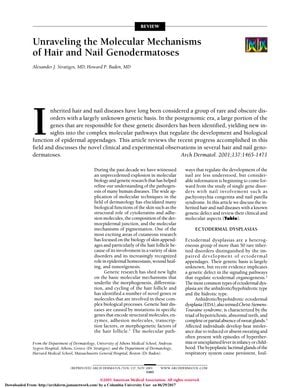Unraveling the Molecular Mechanisms of Hair and Nail Genodermatoses
November 2001
in “
Archives of Dermatology
”
ectodermal dysplasias EDA HED GJB6 Monilethrix hair keratins hHb6 hHb1 Netherton syndrome Trichothiodystrophy Menkes kinky hair syndrome Trichorrhexis nodosa congenital atrichia with papules human nude phenotype pachyonychia congenita K16 K17 Nail-Patella Syndrome LMX1B gene therapy EDA gene HED gene GJB6 gene hair keratin hHb6 hair keratin hHb1 NS TTD PC NPS

TLDR Genetic discoveries are key for understanding, diagnosing, and treating inherited hair and nail disorders.
The document from 2001 reviewed the progress in understanding the molecular mechanisms of inherited hair and nail diseases, highlighting the identification of genes responsible for these disorders. It discussed ectodermal dysplasias, particularly EDA and HED, which are caused by mutations in the EDA and GJB6 genes, respectively. Monilethrix was attributed to mutations in hair keratins hHb6 and hHb1. The document also covered Netherton syndrome (NS), Trichothiodystrophy (TTD), Menkes kinky hair syndrome, Trichorrhexis nodosa, congenital atrichia with papules, the human nude phenotype, and pachyonychia congenita (PC), all linked to specific gene mutations. It emphasized the importance of these discoveries for understanding the pathogenesis of these conditions and their implications for diagnosis and treatment. Additionally, it mentioned Pachyonychia Congenita types 1 and 2, caused by mutations in the K16 and K17 genes, and Nail-Patella Syndrome, caused by mutations in the LMX1B gene. The document concluded that these genetic insights are crucial for understanding the biology of epidermal appendages and anticipated future therapeutic strategies, including gene therapy.